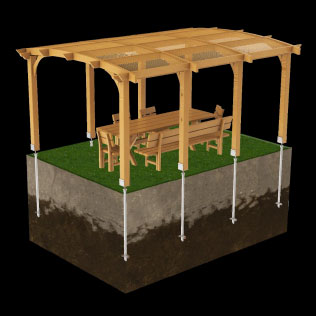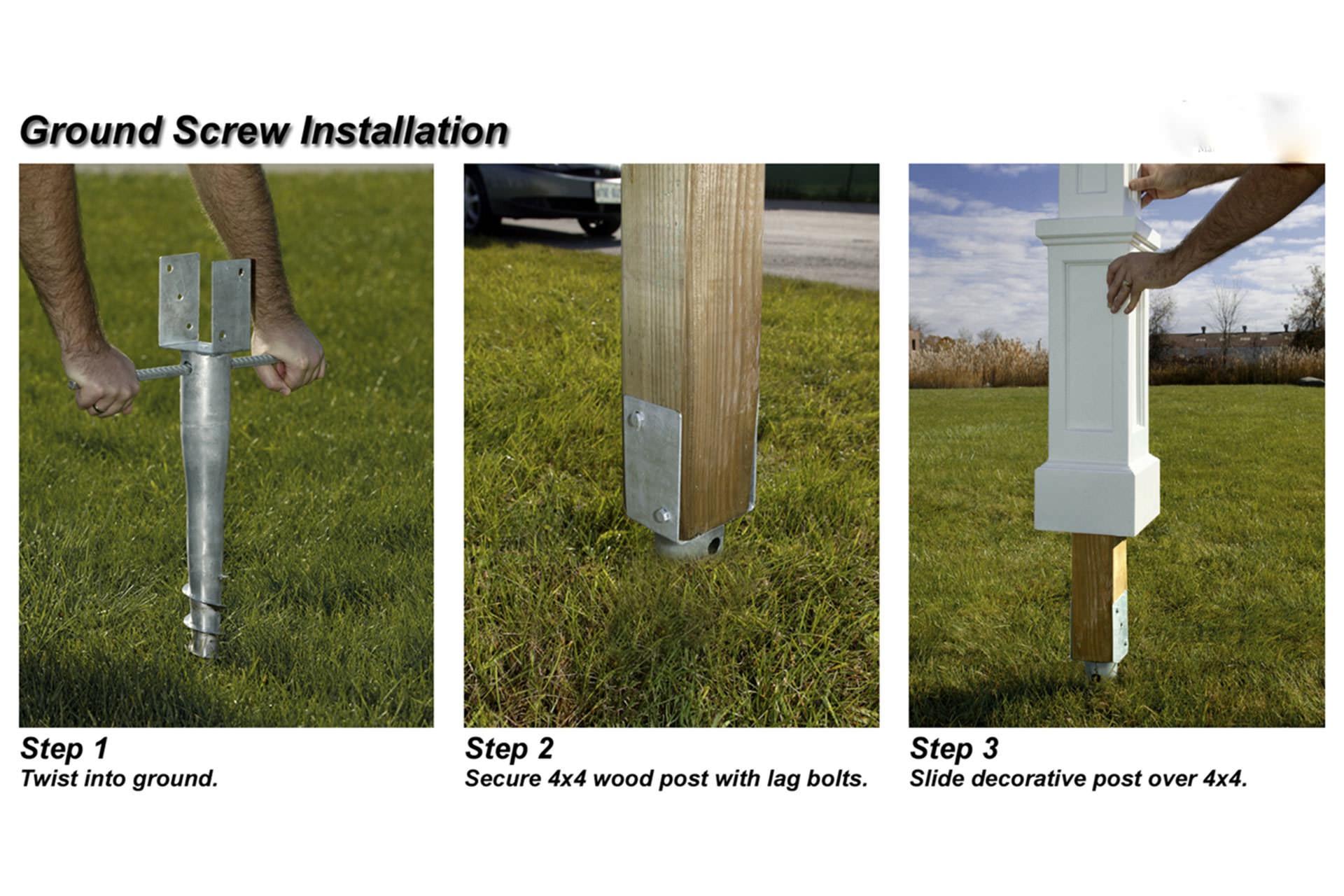To anchor a pergola to the ground, you can use concrete footings or ground anchors inserted vertically into the soil. These provide stability and prevent the structure from shifting or tipping over during strong winds or storms.

Credit: www.westerntimberframe.com
Why Proper Anchoring Is Essential For A Pergola
Importance Of Anchoring For The Safety And Stability Of A Pergola
When it comes to installing a pergola in your outdoor space, proper anchoring is absolutely essential. This not only ensures the safety and stability of the structure, but also helps to maintain its durability over time. Anchoring a pergola correctly can make all the difference in creating a long-lasting and secure addition to your garden or patio area.
Let’s delve deeper into why anchoring is so important:
- Safety first: Anchoring prevents the pergola from tipping over or shifting during strong winds or storms, safeguarding both your loved ones and any items below it. By securely anchoring the pergola, you eliminate the risk of accidents and potential injuries.
- Stability matters: A well-anchored pergola offers superior stability, making it a sturdy and reliable structure. It will not sway or wobble with the slightest breeze, providing a solid foundation for hanging plants, lighting fixtures, or even a hammock. Whether you plan to use your pergola for relaxation or entertainment purposes, stability greatly enhances the overall experience.
- Withstanding harsh weather conditions: By anchoring your pergola properly, you ensure that it can withstand the harshest weather conditions mother nature throws its way. From heavy rain to strong winds, a securely anchored pergola stays in its place, minimizing the risk of damage or collapse. This ensures your investment is protected for years to come.
- Durability is key: Proper anchoring significantly contributes to the overall durability of your pergola. By attaching it firmly to the ground, you prevent unnecessary strain on the structure, reducing the likelihood of warping, bending, or deteriorating over time. An anchored pergola will retain its shape and strength, requiring minimal maintenance and providing long-lasting beauty.
- Enhancing aesthetics: Anchoring a pergola securely not only adds to its functionality but also enhances its visual appeal. A stable structure looks more aesthetically pleasing, conveying a sense of reliability and craftsmanship. With a securely anchored pergola, you can confidently customize and decorate it without worrying about compromising its integrity.
By understanding the importance of proper anchoring for the safety and stability of a pergola, you are well-equipped to install this beautiful outdoor feature with confidence. Whether you’re looking for a cozy spot to relax or an alfresco entertaining area, a well-anchored pergola ensures a safe, durable, and visually appealing addition to your outdoor space.
Factors To Consider Before Anchoring A Pergola
When it comes to anchoring a pergola to the ground, there are several important factors to consider. This ensures the stability, safety, and durability of your pergola. Before you start the installation process, take the time to assess the soil composition and condition, determine the pergola’s location and intended use, as well as understand local building regulations and permits.
Assessing The Soil Composition And Condition
Before you begin anchoring your pergola, it’s crucial to assess the soil composition and condition in your area. Here are some key points to consider:
- Soil type: Determine if your soil is predominantly clay, sandy, or loamy, as this will affect the stability of your pergola.
- Soil moisture: Check the moisture content of the soil. Soil that is too wet or too dry can compromise the anchor’s effectiveness.
- Soil compactness: Assess the compactness of the soil to determine how well it can support the weight of the pergola and withstand external forces.
- Soil drainage: Ensure the soil has sufficient drainage to prevent water accumulation, which could weaken the stability of the anchors.
Determining The Pergola’S Location And Intended Use
The location and intended use of your pergola will also impact the anchoring process. Here are some factors to keep in mind:
- Sun exposure: Consider the direction of the sun and choose a location that provides the desired amount of shade or sunlight for your pergola.
- Wind exposure: Evaluate the wind patterns in your area. Select a spot shielded from strong gusts or be prepared to reinforce the anchoring system.
- Ground slope: Determine if the ground where you plan to install the pergola is sloped. Adjust the anchoring method accordingly to ensure stability on uneven terrain.
- Intended use: Consider how you will use your pergola. If it will support heavy equipment or furniture, you may need to use stronger or additional anchors.
Understanding Local Building Regulations And Permits
Before you start anchoring your pergola, familiarize yourself with local building regulations and permits. Here’s what you need to know:
- Building codes: Research the applicable building codes in your area to ensure compliance. This ensures your pergola meets structural and safety requirements.
- Permits: Determine if you need any permits or approvals before installing your pergola. Check with your local authorities or homeowner’s association to avoid any legal issues or fines.
- Neighborhood covenants: If you live in a neighborhood with covenants or restrictions, review them to ensure your pergola adheres to the guidelines set by your community.
By considering these factors, you’ll be better equipped to anchor your pergola securely and enjoy its benefits for years to come. Remember, it’s important to prioritize safety and compliance with local regulations throughout the installation process.
Different Types Of Pergola Anchoring Methods
Anchoring a pergola to the ground is crucial for its stability and longevity. There are several different methods you can use to ensure your pergola stays firmly in place. We will explore the different types of pergola anchoring methods to help you choose the best option for your outdoor structure.
From in-ground posts to surface mount brackets and specialized anchor systems, we’ve got you covered.
In-Ground Posts
- Digging post holes and setting them in concrete provides a solid foundation for your pergola.
- This method is ideal for areas with soft soil or uneven terrain.
- It requires more effort and time for installation but offers superior stability in the long run.
Using Adjustable Post Anchors
- Adjustable post anchors are a great alternative to the traditional in-ground post method.
- These anchors allow for easier installation and maintenance as they eliminate the need for digging post holes.
- They provide a strong and secure foundation, ensuring your pergola stays firmly anchored to the ground.
- Adjustable post anchors are particularly useful if you plan on relocating or expanding your pergola in the future.
Surface Mount Brackets
- Attaching your pergola to an existing concrete or wood surface is made possible by surface mount brackets.
- This method eliminates the need for digging post holes or setting posts in concrete.
- Surface mount brackets are easy to install and offer a secure way to anchor your pergola without disturbing the ground.
- Exploring the various options for different types of surface mount brackets will help you find the perfect fit for your pergola.
Pergola Anchors And Tie-Down Systems
- For added stability and protection against strong winds, utilizing specialized anchor systems designed specifically for pergolas is recommended.
- These anchor systems offer enhanced security and ensure your pergola remains firmly anchored even in adverse weather conditions.
- There are different types of tie-down systems available, including ground screws, helical anchors, and steel cables.
- Each tie-down system has its unique benefits, such as easy installation, flexibility, or higher load capacities.
Whether you opt for in-ground posts, adjustable post anchors, surface mount brackets, or specialized anchor systems, properly anchoring your pergola to the ground is crucial. Choose the method that suits your specific circumstances and ensure your pergola stands strong for years to come.
Step-By-Step Guide To Anchoring A Pergola
Preparing The Area And Gathering Necessary Tools And Materials
Before you begin anchoring your pergola to the ground, it’s essential to prepare the area and have all the necessary tools and materials on hand. This will ensure a smooth and efficient installation process. Here are the key points to consider:
- Clear the area: Start by removing any obstacles such as rocks, weeds, or debris from the installation site. This will provide a clean and level surface for the pergola.
- Measure and mark: Take accurate measurements to determine the exact placement of your pergola. Use marking tools like stakes and string to outline the area where the posts or surface mount brackets will be installed.
- Gather tools and materials: Make sure you have all the necessary tools and materials ready. This may include a shovel, level, measuring tape, post hole digger, concrete mix (if required), screws or bolts, and a power drill. It’s important to have everything within reach to avoid delays during the installation process.
Proper preparation will lay the foundation for a successful pergola anchoring project. Now that you have gathered your tools and prepared the area, the next step is to install and secure the posts or surface mount brackets.
Frequently Asked Questions For How To Anchor A Pergola To The Ground
How Deep Should The Pergola Anchors Be Buried?
Anchor the pergola by burying the anchors at least 24 inches deep into the ground. This will ensure stability and prevent any shifting or movement during various weather conditions.
Can I Use Concrete Footings To Anchor The Pergola?
Yes, concrete footings are a popular choice for anchoring a pergola. Dig holes in the ground, pour concrete into the holes, and then insert anchor brackets or threaded rods into the wet concrete. Allow the concrete to cure before attaching the pergola.
What Type Of Anchor Is Best For Sandy Soil?
For sandy soil, helical anchors or ground screw anchors work best. These anchors have a spiraled design that provides stability and prevents sinking in loose soil. Make sure the anchors are properly installed and deep enough to hold the weight of the pergola.
Conclusion
Securing your pergola to the ground is crucial for its stability and longevity. By following the steps mentioned in this blog post, you can ensure that your pergola remains firmly anchored in place, even in strong winds or harsh weather conditions.
Remember to choose appropriate anchor types based on your specific requirements and the type of ground you are working with. Additionally, regularly inspecting and maintaining the anchor points will help keep your pergola secure over time. Properly anchoring your pergola will not only provide structural stability but also give you peace of mind knowing that your outdoor space is safe for you and your family to enjoy.
So, go ahead and get started on anchoring your pergola to the ground, and make the most of your outdoor living area for years to come.

